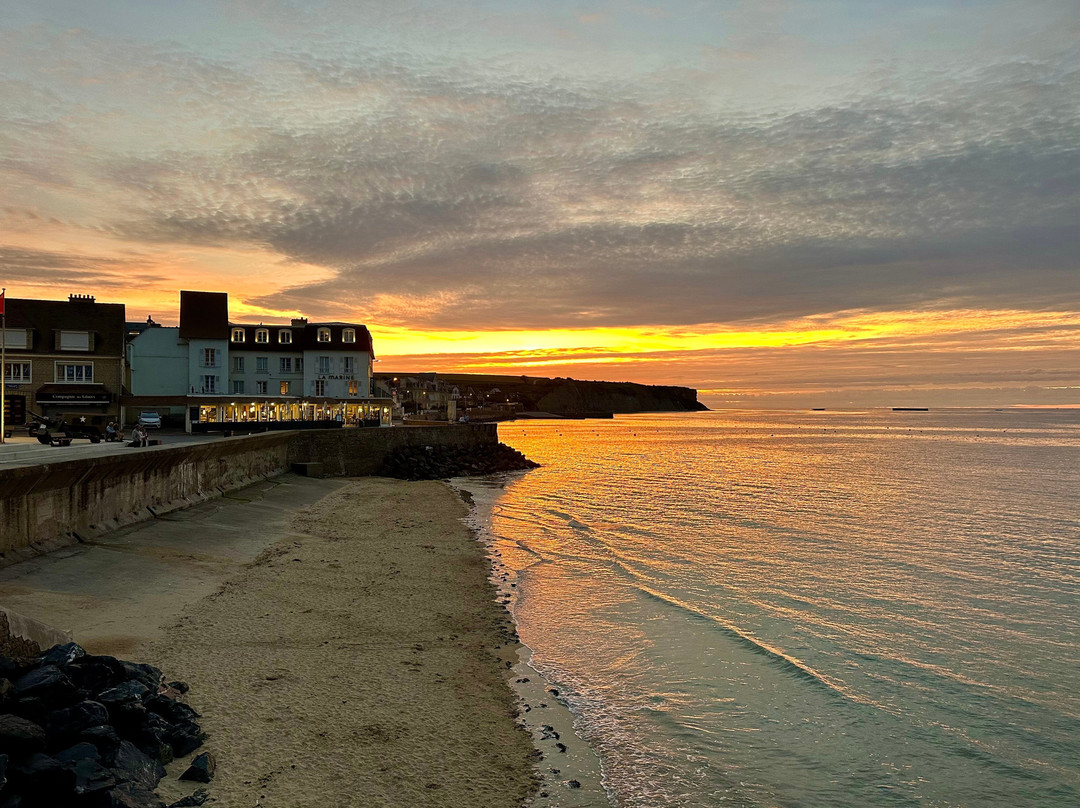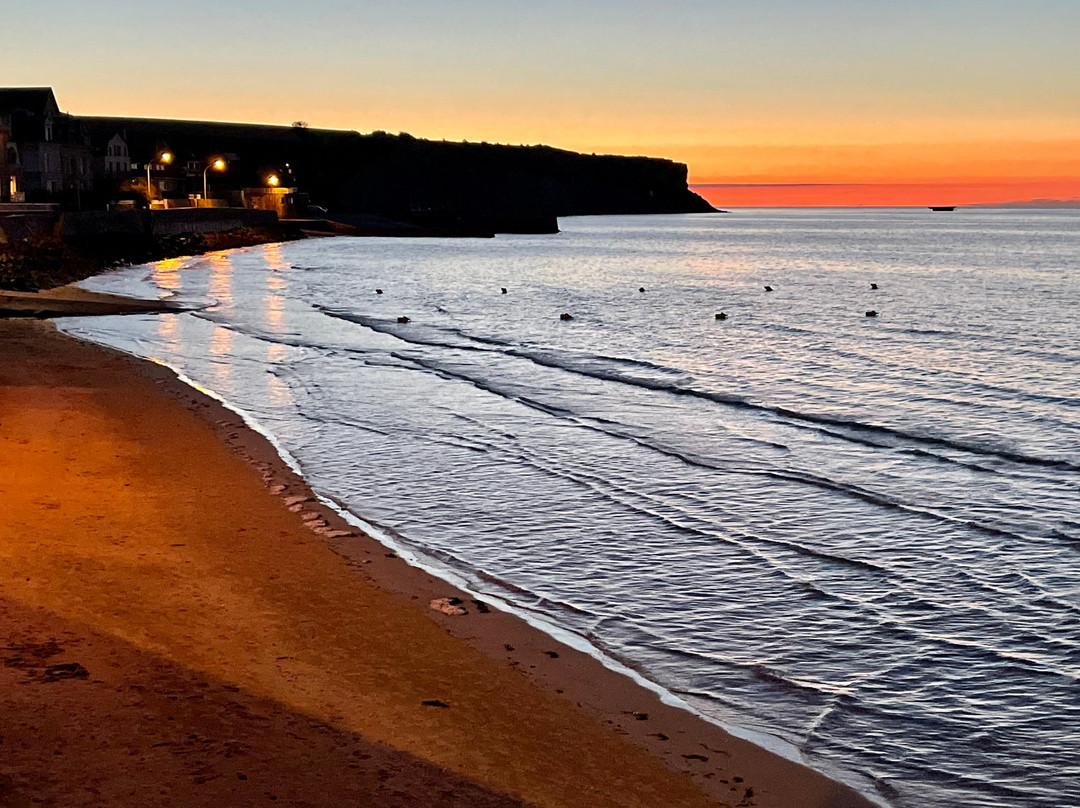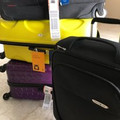的点评
Exploring the WWII D-Day Beaches
Gold Beach的点评
点评:Gold Beach is one of the five WWII D-Day beaches where the Allied invasion of Normandy started. It’s the middle beach and is located near the small town of Arromanches-Les-Bains.
Over a couple of days, we were able to visit all five - Utah, Omaha, Gold, Juno and Sword. It was a very moving experience. The beaches in particular have a sense of the sacred about them.
Nearly 25,000 men of the British 50th Division landed at Gold Beach on June 6, 1944 at 7:25 am. RAF and Royal Navy bombardments preceded the assault, helping to weaken German defences and by that evening, the British had secured the beach-head, pushed 50 km inland and linked up with the Canadians who’d landed at Juno Beach. Between 350 - 400 men had been lost but the losses were much heavier at other beaches like Omaha.
There are lots of tangible reminders and historical remnants of D-Day here.
Unlike some of the beaches which today are popular beach resorts, Gold Beach has retained a lot of its history.
The most obvious remnants are the great hulks of concrete and steel, remnants of the temporary, floating Mulberry Harbours. Without them the D-Day landings could not have succeeded. The remains are strewn along the sandy beach. If you can manage it, try to be here at low tide. You’ll be able to see the remains much more clearly and will even be able to walk around some of them.
Examples of other parts, like the ingenious ’whale’ (which was part of the floating roadway) and the ‘kite’ anchor (which secured the whole thing onto the seabed) can be seen, preserved next to a memorial to Major Alan Beckett.
Several military vehicles and canons have also been preserved on public display around Gold Beach and Arromanches.
If you have the time, it’s well worth walking or driving up to the headland where there are a number of different memorials and historic landmarks. Standing up here and looking back down over the beach and port, gave us a much greater appreciation of what the Allied forces faced as they landed at Gold Beach.
Over a couple of days, we were able to visit all five - Utah, Omaha, Gold, Juno and Sword. It was a very moving experience. The beaches in particular have a sense of the sacred about them.
Nearly 25,000 men of the British 50th Division landed at Gold Beach on June 6, 1944 at 7:25 am. RAF and Royal Navy bombardments preceded the assault, helping to weaken German defences and by that evening, the British had secured the beach-head, pushed 50 km inland and linked up with the Canadians who’d landed at Juno Beach. Between 350 - 400 men had been lost but the losses were much heavier at other beaches like Omaha.
There are lots of tangible reminders and historical remnants of D-Day here.
Unlike some of the beaches which today are popular beach resorts, Gold Beach has retained a lot of its history.
The most obvious remnants are the great hulks of concrete and steel, remnants of the temporary, floating Mulberry Harbours. Without them the D-Day landings could not have succeeded. The remains are strewn along the sandy beach. If you can manage it, try to be here at low tide. You’ll be able to see the remains much more clearly and will even be able to walk around some of them.
Examples of other parts, like the ingenious ’whale’ (which was part of the floating roadway) and the ‘kite’ anchor (which secured the whole thing onto the seabed) can be seen, preserved next to a memorial to Major Alan Beckett.
Several military vehicles and canons have also been preserved on public display around Gold Beach and Arromanches.
If you have the time, it’s well worth walking or driving up to the headland where there are a number of different memorials and historic landmarks. Standing up here and looking back down over the beach and port, gave us a much greater appreciation of what the Allied forces faced as they landed at Gold Beach.
翻译:黄金海滩是二战诺曼底登陆战中盟军发起进攻的五个海滩之一。它位于中部海滩,靠近小镇阿罗芒什莱班。
几天之内,我们参观了全部五个海滩——犹他海滩、奥马哈海滩、黄金海滩、朱诺海滩和宝剑海滩。这是一次非常感人的体验。这些海滩尤其给人一种神圣的感觉。
1944 年 6 月 6 日上午 7:25,英国第 50 师的近 25,000 名士兵在黄金海滩登陆。英国皇家空军和皇家海军在进攻前进行了轰炸,削弱了德国的防御,到那天晚上,英国人已经占领了滩头阵地,向内陆推进了 50 公里,并与登陆朱诺海滩的加拿大人会合。共有 350 至 400 人阵亡,但奥马哈等其他海滩的伤亡要惨重得多。
这里有许多有形的纪念物和诺曼底登陆的历史遗迹。
与如今已成为热门海滩度假胜地的一些海滩不同,黄金海滩保留了许多历史遗迹。
最明显的遗迹是巨大的混凝土和钢铁船体,它们是临时漂浮的桑葚港的遗迹。没有它们,诺曼底登陆就不可能成功。遗迹散落在沙滩上。如果可以的话,尽量在退潮时到这里。您将能够更清楚地看到遗迹,甚至可以在其中一些遗迹周围行走。
可以看到其他部件的例子,例如巧妙的“鲸鱼”(浮动道路的一部分)和“风筝”锚(将整个东西固定在海床上),它们保存在艾伦·贝克特少校的纪念碑旁边。
黄金海滩和阿罗芒什周围还保存了几辆军用车辆和大炮供公众参观。
如果您有时间,步行或开车前往岬角是值得的,那里有许多不同的纪念碑和历史地标。站在这里,回头俯瞰海滩和港口,让我们更加深刻地体会到盟军在黄金海滩登陆时所面临的情况。
几天之内,我们参观了全部五个海滩——犹他海滩、奥马哈海滩、黄金海滩、朱诺海滩和宝剑海滩。这是一次非常感人的体验。这些海滩尤其给人一种神圣的感觉。
1944 年 6 月 6 日上午 7:25,英国第 50 师的近 25,000 名士兵在黄金海滩登陆。英国皇家空军和皇家海军在进攻前进行了轰炸,削弱了德国的防御,到那天晚上,英国人已经占领了滩头阵地,向内陆推进了 50 公里,并与登陆朱诺海滩的加拿大人会合。共有 350 至 400 人阵亡,但奥马哈等其他海滩的伤亡要惨重得多。
这里有许多有形的纪念物和诺曼底登陆的历史遗迹。
与如今已成为热门海滩度假胜地的一些海滩不同,黄金海滩保留了许多历史遗迹。
最明显的遗迹是巨大的混凝土和钢铁船体,它们是临时漂浮的桑葚港的遗迹。没有它们,诺曼底登陆就不可能成功。遗迹散落在沙滩上。如果可以的话,尽量在退潮时到这里。您将能够更清楚地看到遗迹,甚至可以在其中一些遗迹周围行走。
可以看到其他部件的例子,例如巧妙的“鲸鱼”(浮动道路的一部分)和“风筝”锚(将整个东西固定在海床上),它们保存在艾伦·贝克特少校的纪念碑旁边。
黄金海滩和阿罗芒什周围还保存了几辆军用车辆和大炮供公众参观。
如果您有时间,步行或开车前往岬角是值得的,那里有许多不同的纪念碑和历史地标。站在这里,回头俯瞰海滩和港口,让我们更加深刻地体会到盟军在黄金海滩登陆时所面临的情况。




此点评仅代表旅行者个人的主观意见,并不代表TripAdvisor以及其合作方的意见。
关于我们
|
新闻动态
|
商务合作
|
会员中心
|
业主中心
|
业主通
|
常见问题
|
意见反馈
|
联系我们
|
营业执照
© 2025 Tripadvisor 版权所有。
使用条款 |隐私政策 |网站工作原理
部分照片由 VFM Leonardo 提供。
* Tripadvisor不是旅行社,也不是旅游预订服务代理商。我们提供免费、客观、公正的旅游资讯服务。 (显示更多)
TripAdvisor LLC 既不是预订代理商,也不是旅游运营商,不会向网站用户收取任何服务费。 按照规定,在 Tripadvisor 发布机票价格、游览和旅行套餐的合作伙伴(航空公司、旅行提供商及预订代理商),其标价须包含所有费用和附加费用。 例如, 机场出入境税费、消费税与其他服务费、手续费、杂费及附加费用。 当您向我们的某个合作伙伴进行预订时,请务必查阅他们的网站以了解当地行政部门要求的所有适用费用的具体情况。 除非另有说明,机票价格通常指的是一个人的价格(以人民币计)。
为方便起见,TripAdvisor LLC 根据从我们的预订合作伙伴获取的空房率计算每个酒店的均价。 对于游览和景点来说,所显示价格通常是每位成人的最低可用价格。 对于列出的任何旅行套餐或优惠,TripAdvisor LLC 无法保证任何特定的费率或价格。 此外,酒店均价每晚会更新,并以您的首选币种表示(使用现行汇率)。 由于这些已换算的价格是预估价格,因此,有关具体金额和币种请与预订网站进行核实。
此外,TripAdvisor LLC 无法保证我们网站上宣传的价格随时有效。 标价可能需要预订一定天数才能生效,或有不可用日期、使用条件或限制。
TripAdvisor公司对外部网站的内容一概不负责。优惠价格中不含税和其他费用。
ICP证:沪B2-20200433
沪ICP备20013175号
 沪公网安备31010502005427号
沪公网安备31010502005427号鹰程信息技术(上海)有限公司
货币/国家及地区
¥CNY
中国

